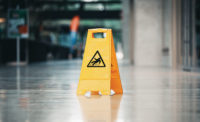Each day that they are in use, forklifts and other types of powered industrial equipment must be inspected prior to operation. But often, not nearly as much thought is given to the battery charging stations that keep many of these essential machines running.
In the hustle of getting started each morning and the haste to go home at the end of a long day, a perfect stage can be set for taking safety shortcuts when it comes to charging batteries. This can be especially true if battery charging areas aren’t well maintained, because the area is perceived as having less importance.
While it can be difficult to combat human nature, it is possible to ensure that battery charging stations are properly equipped for safety. Having the right tools and equipment available also helps to encourage their use and reinforce training.
Designate areas
Battery charging equipment is bulky. It also has specific power requirements and ventilation needs. These are just some of the reasons why OSHA requires designated areas for battery charging [29 CFR 1910.178(g)(1)].
It’s a good idea to locate battery charging areas away from high traffic walkways whenever possible. Painting the floors, installing structural barriers and using signage are all ways to help designate and identify battery charging areas.
Provide PPE
Safety shoes, glasses and work gloves are common staples in distribution centers and warehouses to protect workers from impact and abrasion hazards. In battery charging areas, the hazards are different, making the personal protective equipment (PPE) needs different as well.
Wet-cell batteries contain acid which can splash and cause chemical burns. Stocking PPE, including splash goggles, face shields, aprons and chemically resistant gloves will help to ensure that employees have the right protection for splash hazards.
Prepare for splashes
In addition to PPE, eyewash stations and drench showers are required in battery charging areas because employees could be splashed with a corrosive liquid [29 CFR 1910.151(c )]. Eyewash stations or drench showers should be placed or installed near the charging area so that they can be used immediately when they are needed.
Like eyewash stations and drench showers in other areas, they need to provide a steady flow of clean, tepid water. Employees must be able to flush effected areas for a minimum of 15 minutes.
Stock tools
Batteries are heavy. Many weigh 1,000 pounds or more. When they do not remain in the forklift or truck during charging; hoists, conveyors or other handling equipment are required tools to help employees move batteries into and out of charging areas.
To help ensure that the right tools are used, review the battery charging procedures that have been established for the facility. Ensure that the tools required, such as funnels, siphons, and non-sparking wrenches are all readily available so that employees aren’t tempted to improvise or substitute another tool to get the job done quickly.
Mount fire extinguishers
As batteries are charging, they emit hydrogen gas. Therefore, it is essential to keep all sources of ignition, such as cigarettes, sparks and open flames away from battery charging areas. Proper ventilation helps to keep hydrogen levels in check, but other safeguards, such as fire extinguishers are also required.
Fire extinguisher can help to extinguish an incipient fire. Select extinguishers that are appropriate for the materials and hazards in the area. Train employees on how to use the extinguisher and how to recognize when the fire is beyond their capabilities to extinguish; and ensure that exit routes are clearly marked.
Be ready for spills
Removing caps and topping off charge batteries can cause battery acid spills. Because battery acid is corrosive, it presents a chemical burn hazard and a slip and fall hazard if the spill is left on the floor. Additionally, acid spills that are not cleaned up can erode the floor in the battery charging area.
Provide spill response kits that contain absorbents and neutralizers to quickly contain and control spills. Response materials should also include brooms, dustpans and disposal bags so that spent materials can be picked up and easily removed from the area.
Post instructions
Training helps to educate employees, and retraining serves as a reminder of lessons previously taught; but it can be hard to remember everything. Posting instructions in battery charging areas helps to remind everyone of the hazards present in battery charging area as well as the precautions that they need to take to keep themselves safe.
Signs can be pictorial to remind employees of the PPE needed. They may also be instructional, including each step in the process. Consider any warnings that may also be necessary in the area, such as removing metal jewelry or only adding water to batteries after charging is complete.
Charging batteries at the end of the shift is a routine part of the workday for most material handing operators. Keeping battery charging areas clean, well-maintained and stocked with the tools, PPE and other items needed can help prevent electrical shock, chemical splashes, fires and other unsafe conditions.



